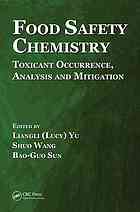

Most ebook files are in PDF format, so you can easily read them using various software such as Foxit Reader or directly on the Google Chrome browser.
Some ebook files are released by publishers in other formats such as .awz, .mobi, .epub, .fb2, etc. You may need to install specific software to read these formats on mobile/PC, such as Calibre.
Please read the tutorial at this link: https://ebookbell.com/faq
We offer FREE conversion to the popular formats you request; however, this may take some time. Therefore, right after payment, please email us, and we will try to provide the service as quickly as possible.
For some exceptional file formats or broken links (if any), please refrain from opening any disputes. Instead, email us first, and we will try to assist within a maximum of 6 hours.
EbookBell Team

4.0
96 reviews''1 Food Safety Chemistry An Overview Haiqiu Huang and Liangli (Lucy) Yu 1.1 Introduction Food safety is of paramount importance to both consumers and food industry. According to Food and Agriculture Organization (FAO), food safety is defined as ''absence or acceptable and safe levels of contaminants, adulterants, naturally occurring toxins or any other substance that may make food injurious to health on an acute or chronic basis.''1 In 2008, a perspective article published in the New England Journal of Medicine indicated that ''globalization and international agribusiness allow problems with food supply to spread around the planet all too quickly,''2 which indicates that food safety has become a critical concern in human health and life quality worldwide regardless of the geological location or the degree of economic development. Up until now, the major attention of food safety has been given to food microbiology- related issues, which result from microorganism contamination and outbreak, and characterized by suddenness and unexpectedness. However, food microbiologyrelated issues are only one part of the food safety problems''--
''1 Food Safety Chemistry An Overview Haiqiu Huang and Liangli (Lucy) Yu 1.1 Introduction Food safety is of paramount importance to both consumers and food industry. According to Food and Agriculture Organization (FAO), food safety is defined as ''absence or acceptable and safe levels of contaminants, adulterants, naturally occurring toxins or any other substance that may make food injurious to health on an acute or chronic basis.''1 In 2008, a perspective article published in the New England Journal of Medicine indicated that ''globalization and international agribusiness allow problems with food supply to spread around the planet all too quickly,''2 which indicates that food safety has become a critical concern in human health and life quality worldwide regardless of the geological location or the degree of economic development. Up until now, the major attention of food safety has been given to food microbiology- related issues, which result from microorganism contamination and outbreak, and characterized by suddenness and unexpectedness. However, food microbiologyrelated issues are only one part of the food safety problems''